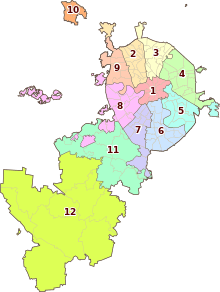Meshchansky District
Coordinates: 55°46′33″N 37°37′39″E / 55.77583°N 37.62750°E

.png)
Meshchansky District (Russian: Мещанский район) is a district of Central Administrative Okrug of the federal city of Moscow, Russia. Population: 58,002 (2010 Census);[1] 56,077 (2002 Census).[2]
The district extends due north from Kitai-gorod to Kamer-Kollezhsky Val. Western boundary with Tverskoy District follows the track of Neglinnaya River (Neglinnaya Street, Tsvetnoy Boulevard, Samotechnaya Street, Soviet Army Street). Eastern boundary with Krasnoselsky District follows Bolshaya Lubyanka Street and Sretenka Street, then one block east from Mira Avenue. The Lubyanka Building lies in the Meshchansky District.
The district contains part of Kuznetsky Most Street, Rozhdestvensky monastery and Rozhdestvensky Boulevard, Olympic Stadium and a row of neoclassical, palace-like buildings north from the Garden Ring. It houses headquarters of Federal Security Service in Lubyanka Square, Central Bank of the Russian Federation, FAPSI and other government agencies.
Etymology
Meshchane in the Russian Empire denoted a social estate of poor town residents who did not qualify as merchants or civil servants; in modern Russian, it is a pejorative name for a narrow-minded philistine. Meschansky District acquired its name earlier, in the second half of 17th century, through the Ukrainians and Belarusians abducted from their hometowns in the course of Russo-Polish War (1654–1667). These people settled north from present-day Garden Ring, reaching 692 households by 1682 (Sytin, p.296). In their languages, meshchane meant simply "town people", "the locals", without negative connotation; the name of Meshchanskaya sloboda persists to date.
Symbols on the coat of arms denote:
- Golden horn of plenty - the Central Bank
- Red bridge - Kuznetsky Most
- The cannon - old Moscow Armoury (пушечный двор) in present-day Pushechnaya Street
Gallery
North from Garden Ring: four historical buildings in a row are divided between Meshchansky and Maryina Roshcha District
-
.jpg)
Catherine's Institute, present-day House of Culture of Russian Army
-

Mariinsky Hospital, birthplace of Fyodor Dostoyevsky, and 1918 monument to Dostoyevsky
-

Alexander's Institute, also a public hospital
-

Russian Army Theater
References
Notes
- ↑ Russian Federal State Statistics Service (2011). "Всероссийская перепись населения 2010 года. Том 1" [2010 All-Russian Population Census, vol. 1]. Всероссийская перепись населения 2010 года (2010 All-Russia Population Census) (in Russian). Federal State Statistics Service. Retrieved June 29, 2012.
- ↑ Russian Federal State Statistics Service (May 21, 2004). "Численность населения России, субъектов Российской Федерации в составе федеральных округов, районов, городских поселений, сельских населённых пунктов – районных центров и сельских населённых пунктов с населением 3 тысячи и более человек" [Population of Russia, Its Federal Districts, Federal Subjects, Districts, Urban Localities, Rural Localities—Administrative Centers, and Rural Localities with Population of Over 3,000] (XLS). Всероссийская перепись населения 2002 года [All-Russia Population Census of 2002] (in Russian). Retrieved August 9, 2014.
Sources
- П. В. Сытин, "Из истории московских улиц", М. 1948
- City law on district boundaries, current version
- Year of Dostoyevsky's monument referenced to: "Архитектура РСФСР за XXX лет", М, 1949
External links
- Official website of Meshchansky District (Russian)
